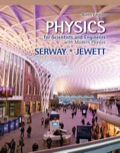
Concept explainers
A laboratory
(a)
Answer to Problem 29.10P
Explanation of Solution
Given info: A magnetic field of magnitude
Explanation:
The formula to calculate the Magnetic force acting on a moving charge particle is,
Here,
The cross product of
Here,
Substitute
The cross product is maximum for
The mass of proton is
Substitute
Conclusion:
Therefore, the maximum magnetic force that is exerted on the proton is
(b)
Answer to Problem 29.10P
Explanation of Solution
Given info: A magnetic field of magnitude
Explanation:
The formula to calculate the force acting on a proton of mass
Here,
Substitute
Conclusion:
Therefore, the magnitude of maximum acceleration of the proton is
(c)
Answer to Problem 29.10P
Explanation of Solution
Given info: A magnetic field of magnitude
Explanation:
The formula to calculate the Magnetic force acting on a moving charge particle is,
Here,
The cross product of
Here,
Substitute
The cross product is maximum for
The mass of electron is
Substitute
Conclusion:
Therefore, the maximum magnetic force that is exerted in the case of proton is same for the electron.
(d)
Answer to Problem 29.10P
Explanation of Solution
Given info: The proton makes an angle of
Explanation:
The formula to calculate the force acting on a proton of mass
Here,
Substitute
Conclusion:
Therefore, the magnitude of maximum acceleration obtained in the case of proton is not same for the electron.
Want to see more full solutions like this?
Chapter 29 Solutions
EBK PHYSICS FOR SCIENTISTS AND ENGINEER
- Help me make a visualize experimental setup using a word document. For the theory below.arrow_forwardHow to solve this, given answerarrow_forwardThree point-like charges are placed at the corners of a square as shown in the figure, 28.0 cm on each side. Find the minimum amount of work required by an external force to move the charge q1 to infinity. Let q1=-2.10 μC, q2=+2.40 μС, q3=+3.60 μC.arrow_forward
- A point charge of -4.00 nC is at the origin, and a second point charge of 6.00 nC is on the x axis at x= 0.820 mm . Find the magnitude and direction of the electric field at each of the following points on the x axis. x2 = 19.0 cmarrow_forwardFour point-like charges are placed as shown in the figure, three of them are at the corners and one at the center of a square, 36.0 cm on each side. What is the electric potential at the empty corner? Let q1=q3=+26.0 µС, q2=-28.0 μC, and q4=-48.0μc Varrow_forwardPLS HELparrow_forward
 Glencoe Physics: Principles and Problems, Student...PhysicsISBN:9780078807213Author:Paul W. ZitzewitzPublisher:Glencoe/McGraw-Hill
Glencoe Physics: Principles and Problems, Student...PhysicsISBN:9780078807213Author:Paul W. ZitzewitzPublisher:Glencoe/McGraw-Hill Principles of Physics: A Calculus-Based TextPhysicsISBN:9781133104261Author:Raymond A. Serway, John W. JewettPublisher:Cengage Learning
Principles of Physics: A Calculus-Based TextPhysicsISBN:9781133104261Author:Raymond A. Serway, John W. JewettPublisher:Cengage Learning College PhysicsPhysicsISBN:9781938168000Author:Paul Peter Urone, Roger HinrichsPublisher:OpenStax College
College PhysicsPhysicsISBN:9781938168000Author:Paul Peter Urone, Roger HinrichsPublisher:OpenStax College Physics for Scientists and Engineers with Modern ...PhysicsISBN:9781337553292Author:Raymond A. Serway, John W. JewettPublisher:Cengage Learning
Physics for Scientists and Engineers with Modern ...PhysicsISBN:9781337553292Author:Raymond A. Serway, John W. JewettPublisher:Cengage Learning Physics for Scientists and Engineers: Foundations...PhysicsISBN:9781133939146Author:Katz, Debora M.Publisher:Cengage Learning
Physics for Scientists and Engineers: Foundations...PhysicsISBN:9781133939146Author:Katz, Debora M.Publisher:Cengage Learning College PhysicsPhysicsISBN:9781305952300Author:Raymond A. Serway, Chris VuillePublisher:Cengage Learning
College PhysicsPhysicsISBN:9781305952300Author:Raymond A. Serway, Chris VuillePublisher:Cengage Learning





